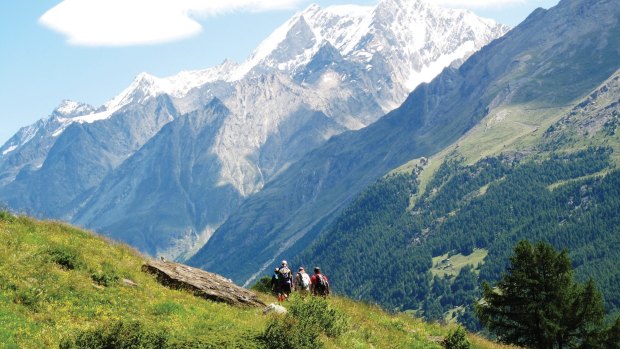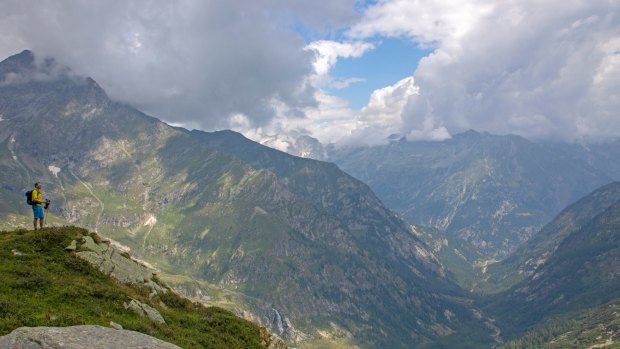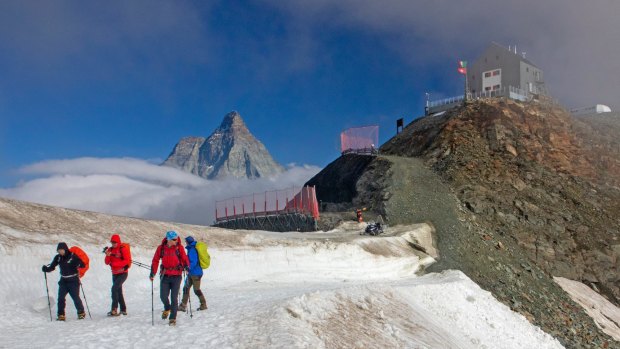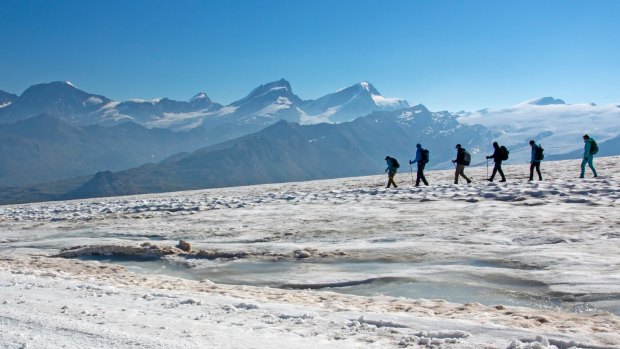This was published 6 years ago
Monte Rosa hiking, Switzerland to Italy: The most spectacular place in Europe
By Andrew Bain

Each year more than 10,000 people hike the equivalent Tour du Mont Blanc (TMB), and yet hours will regularly pass on the Tour de Monte Rosa without us seeing another hiker.Credit: UTracks
Atop Monte Moro Pass, a golden Madonna stands metres high, her hands reaching gracefully forwards into Italy and her back turned on Switzerland. From her feet, the two countries plunge away into deep valleys. I've just climbed out of Switzerland, and I'm about to descend into Italy.
"We have a saying where I come from: 'I have seen the Virgin'," says one of my French hiking companions. "It means you're crazy or drunk. And now I really have seen the Virgin."
But we aren't crazy, and the only thing we're drunk on is the scenery and the clear mountain air. Ahead of us, the summit of Monte Rosa rises above cloud, with a large glacier scraping down its slopes and into the valley three vertical kilometres below.

A hiker approaching Colle del Turlo, one of a string of high passes along the Tour de Monte Rosa.Credit: Andrew Bain
Mountains recede in waves to the horizon, and the valleys are so deep they disappear from view below us. It's a scene that elsewhere might draw a crowd, but here we share it with just a handful of other hikers.
It's one of those moments when second seems best. At 4634 metres above sea level, Monte Rosa is the Alps' second-highest peak, but it draws just a fraction of the visitor attention of the taller Mont Blanc.
I'm hiking the Tour de Monte Rosa, circuiting this massif that sprawls across the Italian-Swiss border. Each year more than 10,000 people hike the equivalent Tour du Mont Blanc (TMB), and yet hours will regularly pass on the Tour de Monte Rosa without us seeing another hiker.

The Matterhorn rises above the clouds, a group of hikers and Rifugio Teodulo.Credit: Andrew Bain
It's a consequence purely of numbers, because the Tour de Monte Rosa has many features that make it more appealing and exciting than the TMB. I've now hiked both and far prefer the Monte Rosa circuit.
Just like the TMB, it's an international walk, crossing from Switzerland to Italy and back, passing across the toes of the Alps' most shapely mountain, the Matterhorn, as it does so. Its highest point is about 3300 metres compared to 2600 metres on the standard TMB route, and includes a long section atop a glacier.
It's also the more challenging of the two mountain circuits, presenting a queue of 1000-metre-plus climbs and descents, bottoming out in valleys so narrow that the next climbs begin again immediately.

Trekkers descending on a glacier from Rifugio Teodulo, part of the Tour de Monte Rosa. Credit: Andrew Bain
On Monte Moro Pass, I'm a day-and-a-half into my week-long circuit of Monte Rosa, having set out the previous morning from the Swiss village of Graechen at the massif's northern tip. Just below the golden statue, hikers snooze in the sun in a cafe's deck chairs, and a cable car whisks a smattering of people on and off the pass.
Our way down is more testing – a 1600-metre descent on foot, transitioning through multiple environments, crossing a boulder field, picking through alpine meadows and heading finally into the pine forest that darkens the lower slopes. The cable car regularly drifts overhead, like temptation hovering just out of reach.
It's a descent that ends in Macugnaga, an Italian town in a Swiss wardrobe of dark wooden chalets and geranium-brightened balconies. From its central piazza the view rises a staggering 3300 metres to the glaciated tip of Monte Rosa.
In Macugnaga it becomes quickly clear that the Alps are more than one homogenous entity. One of the Frenchmen hiking with me is Guillaume, who has driven three hours to Monte Rosa from his home in Annecy in the French Alps.
"Everything here is so different to me," he says. "The atmosphere, the food, even the mountains and the glaciers are different." And on this walk, things can differ wildly day by day. The previous night we'd been in Switzerland, dining on spaetzle noodles and beer; now we're in Italy with lasagne, polenta and grappa spread before us.
The next morning, another pass awaits us – another climb of 1400 metres to the Colle del Turlo.
"Is this the hardest day?" I hear one hiker ask our guide, Sandra. "No," she's says with a grin. "They're all hard."
The days roll on like this – over passes and into deep valleys. Atop one pass, the Col d'Olen, as a storm blows violently past us, ibex clatter about the rocks, their horns as wide as the handlebars on a Harley.
Cable cars whirr up and down the slopes like commuter trains, and all around us peaks rise like barbs. For the next two nights we'll stay higher up the slopes, in mountain huts beside Lake Gabiet and then in the tiny, four-building Walser village of Resy, which at 2080 metres above sea level was once one of the highest permanently settled villages in Europe.
As we set out from Resy the next morning, we're two days from the end of our hike, but the best is still seemingly ahead. The second-last pass of our walk, and the sixth pass thus far, is Cime Bianche, reached along a stunning route from Resy that weaves through alpine meadows veined with running streams. High overhead, glaciers are trowelled so thickly onto the mountaintops that they resemble icing on a wedding cake.
The Tour's most dramatic and beautiful moment – thus far, at least – comes just below the pass, where a pair of lakes as blue as eyes sit side by side beneath barren rock walls. Waterfalls skid down the rock face from a higher lake that only reveals itself as we make the final climb to the pass. It's high drama in the high mountains.
Cime Bianche should signal the moment I've been anticipating for six days, for it's here that the Matterhorn finally rises into view ... at least in theory. As we crest the pass, there it sits, behind cloud, out of sight.
The pass also marks the most dramatic shift in the mountain's environment as the trail now dips into the barren Cervinia ski fields. From copious wildflowers, there's suddenly no life – an Alpine landscape transformed into an alien landscape.
Crunching across gravel, we rise onto snow patches and finally to the Tour's highest point and our final home on the trail: Rifugio Teodulo, perched atop a ridge at 3300 metres. It's the highest of the Tour's huts, but also the most stylish, with a living area of long leather sofas and wall-length windows that stare out at the Matterhorn. The hut also straddles the border, with its dining room in Italy and its bar in Switzerland. I sip a beer in one country and eat dinner in the other.
We wake again the next morning to thick fog, obliterating views of everything, including the still-unsighted Matterhorn. This morning we're leaving the mountains, and ending our hike, heading down into Zermatt along the glacier that runs like an ice road past the refuge.
For two hours the cloud sits heavy on the mountains, but as we rope up beside the glacier, tying ourselves together for safety, the fog suddenly parts and the Matterhorn breaks through like a launched rocket.
No sooner does it appear than it begins to spin cloud around itself again – it will be a brief cameo from one of the world's most spectacular mountains. Ice crunches beneath the crampons on our feet, and though we step around a few small crevasses, there are no dangers here on this glacier that doubles as a ski run.
The way is clear and easy, and to one side of me rises the Alps' second-highest peak, and on the other, the piercing figure of the Matterhorn. There's arguably no more spectacular place to be in Europe.
FIVE MOUNTAIN CIRCUITS
TORRES DEL PAINE
Most hikers come for the W Trek along one side of Chile's bristly massif, but the Paine Circuit crosses to more remote country along its other edge.
TONGARIRO NORTHERN CIRCUIT
Thread between the volcanoes of New Zealand's North Island, lapping Ngauruhoe (aka Mt Doom in Lord of the Rings).
DIENTES CIRCUIT
The world's southernmost trek makes a lap through the well-named Dientes de Navarino – the Teeth of Navarino – on Chile's far-southern Navarino Island.
ANNAPURNA CIRCUIT
Once the most popular trek in Nepal, now fading towards obscurity by the roads constructed through the valleys.
KAILASH CIRCUIT
Join the pilgrims in lapping 52 kilometres around one of Asia's holiest mountains, the 6638-metre Mount Kailash. If you really want heavenly credits, you'll need to walk around it 13 times.
TRIP NOTES
MORE
TRAVEL
Qatar Airways flies from Sydney and Melbourne to Zurich via Doha. A Rail Europe Swiss Travel Pass allows unlimited train and bus travel, with both Graechen and Zermatt easily connected to Zurich. See qatarairways.com raileurope.com.au
HIKE
UTracks runs a seven-day guided Tour de Monte Rosa trip (from $1750), starting in Graechen and finishing in Zermatt. See utracks.com
Andrew Bain travelled as a guest of UTracks and Rail Europe.
Sign up for the Traveller Deals newsletter
Get exclusive travel deals delivered straight to your inbox. Sign up now.